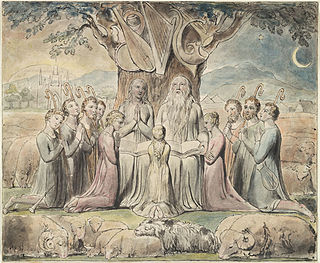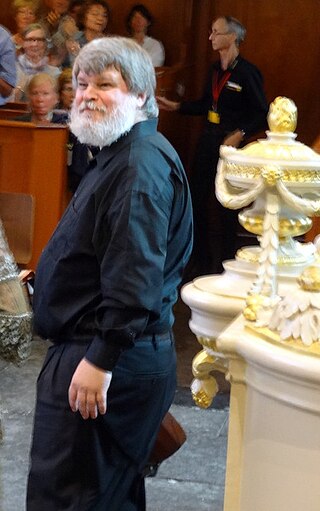
The galliard was a form of Renaissance dance and music popular all over Europe in the 16th century. It is mentioned in dance manuals from England, Portugal, France, Spain, Germany, and Italy.

The pavane is a slow processional dance common in Europe during the 16th century (Renaissance).

Renaissance dances belong to the broad group of historical dances, specifically those during the Renaissance period. During that period, there was a distinction between country dances and court dances. Court dances required the dancers to be trained and were often for display and entertainment, whereas country dances could be attempted by anyone. At Court, the formal entertainment would often be followed by many hours of country dances which all present could join in. Dances described as country dances such as Chiarantana or Chiaranzana remained popular over a long period – over two centuries in the case of this dance. A Renaissance dance can be likened to a ball.

William Kempe, commonly referred to as Will Kemp, was an English actor and dancer who specialised in comic roles. He was best known as one of the original stage actors in early dramas by William Shakespeare, and roles associated with his name may have included the comic creation Falstaff. His contemporaries considered him to be a successor to the great clown of the previous generation, Richard Tarlton.
John Jenkins (1592–1678), was an English composer who was born in Maidstone, Kent and who died at Kimberley, Norfolk.

Historical dance is a term covering a wide variety of Western European-based dance types from the past as they are danced in the present. Today historical dances are danced as performance, for pleasure at themed balls or dance clubs, as historical reenactment, or for musicological or historical research.

David Martin Bevington was an American literary scholar. He was the Phyllis Fay Horton Distinguished Service Professor Emeritus in the Humanities and in English Language & Literature, Comparative Literature, and the college at the University of Chicago, where he taught since 1967, as well as chair of Theatre and Performance Studies. "One of the most learned and devoted of Shakespeareans," so called by Harold Bloom, he specialized in British drama of the Renaissance, and edited and introduced the complete works of William Shakespeare in both the 29-volume, Bantam Classics paperback editions and the single-volume Longman edition. After accomplishing this feat, Bevington was often cited as the only living scholar to have personally edited Shakespeare's complete corpus.

Job: A Masque for Dancing is a one-act ballet produced in 1931. The scenario is by Geoffrey Keynes, the choreography by Ninette de Valois, and the music by Ralph Vaughan Williams. The ballet is based on the Book of Job from the Hebrew Bible and was inspired by the illustrated edition by William Blake. The music was first given in concert in 1930 and the ballet had its stage premiere on 5 July 1931. It was the first ballet to be produced by an entirely British creative team. It was taken into the repertoire of the Vic-Wells Ballet and its successors, and has been intermittently revived.

Brian Bedford was an English actor. He appeared in film and on stage, and was an actor-director of Shakespeare productions. Bedford was nominated for seven Tony Awards for his theatrical work, winning once.

Paul Raymond O'Dette is an American lutenist, conductor, and musicologist specializing in early music.
In the Elizabethan era (1558–1603), there was a wide range of leisure activities entertaining both the nobility and the common classes. Among these leisure activities were animal fighting, team sports, individual sports, games, dramatics, music and the arts.
Time Vindicated to Himself and to his Honours was a late Jacobean era masque, written by Ben Jonson and with costumes, sets, and stage effects designed by Inigo Jones. James's son and heir Prince Charles led the dances of the principal masquers, as he had in several previous masques at the Stuart Court.

The Shakespearean fool is a recurring character type in the works of William Shakespeare.

The Duke's Company was a theatre company chartered by King Charles II at the start of the Restoration era, 1660. Sir William Davenant was manager of the company under the patronage of Prince James, Duke of York. During that period, theatres began to flourish again after they had been closed from the restrictions throughout the English Civil War and the Interregnum. The Duke's Company existed from 1660 to 1682, when it merged with the King's Company to form the United Company.
The Law Against Lovers was a dramatic adaptation of Shakespeare, arranged by Sir William Davenant and staged by the Duke's Company in 1662. It was the first of the many Shakespearean adaptations staged during the Restoration era.
Old measures, or simply measures, were a group of dances performed at ceremonial and festive occasions in Early Modern Britain. Some of the dances included in the measures were the pavane and the almain, and dances such as the galliard and the courante are also mentioned as accompanying or following the traditional measures.

The Maynardville Open-Air Theater is an outdoor theatre in Maynardville Park, Wynberg, Cape Town, South Africa. It seats 720 people and is known for its annual Shakespeare in the Park plays.

In theatres, beginning in Elizabethan London, a jig was a short comic drama that immediately followed a full-length play. This phenomenon added an additional comic or light-hearted offering at the end of a performance. A jig might include songs sung to popular tunes of the day, and it might feature dance, stage fighting, cross-dressing, disguisings, asides, masks, and elements of pantomime.
This is an alphabetical index of articles related to the Renaissance.
Music in the plays of William Shakespeare includes both music incidental to the plot, as song and dance, and also additional supplied both by Shakespeare's own company and subsequent performers. This music is distinct from musical settings of Shakespeare's sonnets by later composers.













